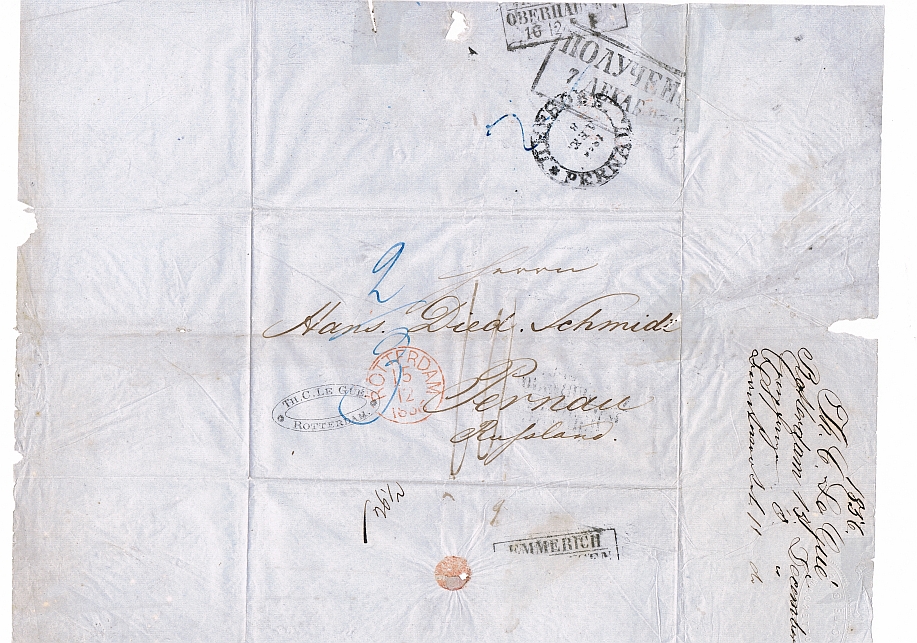Estonia
-
Royal Swedish Post
-
Imperial Russian Post
With the founding of the new capital of the Russian Empire, St. Petersburg, on May 27, 1703 at the mouth of the Neva into the Baltic Sea, Tsar Peter I made it clear that he was no longer willing to accept Sweden's claim to supremacy in the Baltic region. Instead, he sought to extend the Russian sphere of power directly to the coasts of the Baltic Sea. This was achieved as a result of the Northern War (1701–1721)..

Map of the Russian Baltic Provinces
(Image: Meyers Konversationslexikon (1893-97) / Wikimedia Commons)
The Russian Baltic provinces of Estonia, Livonia and Courland largely covered the territory of the present-day republics of Estonia and Latvia. The Russian Baltic province of Estonia, on the other hand, only comprised the northern part of present-day Estonia, while its southern part was not administered from Reval (Tallinn), but as part of the province of Livonia from Riga. It was only with the division of Livonia along the Estonian-Latvian language border in 1918 that the territory of the present-day Republic of Estonia came into being.

Map of the Estonian Governorate
(Image: Map from 1820 / Wikimedia Commons)

Map of the Livonian Governorate
(Image: Map from 1820 / Wikimedia Commons)
Postal system in Russia from 1710
On November 25, 1710, the Governor General of Livonia ordered the reopening of postal routes and stations in Livonia and Estonia. Until 1712 these were operated by Cossacks, from 1713 by the Estonian and Livonian knighthood, and occasionally also by peasants. Since the latter had received the right to dispose of the majority of the revenue in return for maintaining the postal routes and stations, the situation arose over constant conflicts between the "private shareholders" and the Russian state (postal) administration over a period of 181 years (1713-1894). These conflicts only ended in 1894 with the increased centralisation and russification of the postal administration in the Baltic provinces (establishment of postal agencies and offices).
First postmarks
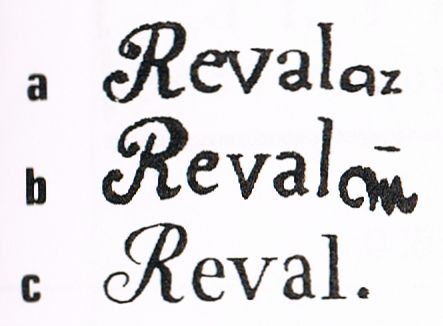
Reval postmark
Hurt/Ojaste No. 56:1Initially, mail items were marked exclusively by handwriting. It was not until 1796 that Dorpat (Tartu) introduced the first postmark, followed by Reval (Tallinn) from 1799. These postmarks were only used by the post offices (in the district towns).

Dorpat postmarks
Hurt/Ojaste No. 16:1With the postal reform of 1830, it was specified that postmarks were used at the postal stations and special arrival stamps at the post offices. The resulting postmarks in Estonia are very diverse. There were only eleven post offices in Estonia: the governorate post office in Reval (Tallinn), the district post offices in Arensburg (Kuresaare), Dorpat (Tartu), Fellin (Viljandi), Hapsal (Haapsalu), Pernau (Pärnu), Walk (Valga), Werro (Võru) and Wesenberg (Rakvere) as well as the post offices in Jewe (Jõhvi) and Narwa (Narva). These so-called "pre-philatelic" postmarks, used before the issue of Russia's first postage stamp on January 1, 1858, remained in use until around 1870. 1870 to indicate the place of departure and destination of a postal item.
The stamps introduced in 1858 were (additionally) cancelled with a so-called "dot number stamp".

Dot number stamp, used 1858 – 1877 (Hurt/Ojaste Type 2).
Usage: Governorate post offices: circular, District post offices: square, Border post offices (did not occur in Estonia): oval, Other post offices: hexagonal, Post stations: triangular.
From 1860 onwards, however, date-circle stamps produced according to a uniform pattern were used throughout the empire for the first time:
Before philately? - Without stamps from Rotterdam to Pernau
The issue of the first stamp in Great Britain on May 6, 1840 marked the beginning of philately, the love of franking in all its forms. Mail had of course existed for a long time before that, but letters on paper with postmarks had not been around for quite so long. Let us take a closer look at such a letter "without stamps", exemplary for an incoming mail in the Imperial Russian period:
The envelope (ex Reinhard Heinrich), shown somewhat smaller, is a typical folded letter of the time, recognisable by the fold marks and the red dry seal with which the letter was sealed.
We know nothing about its contents. Perhaps it was an order or a companion letter, sent overland in parallel with a shipload. The company that sent it no longer exists. According to the handwritten note, the letter was dispatched on December 15, 1856. with the oval sender's stamp "Th. C. Le Gué Rotterdam" and posted on the same day, apparent by the red single-circle postmark of the Rotterdam post office. The addressee was the trading house Hans-Dietrich Schmidt in Pernau/Russia (today Pärnu, Estonia), which existed from 1741 to 1940.
The first noticeable postmark is "Emmerich Oberhausen 16 12". (a part is visible at the bottom, the rest now at the top due to the unfolding of the letter). This is a Prussian railway postmark, which proves that the letter was transported by the most modern and fastest means of transport at that time, the train. The letter was transported further overland through Prussia to Russia, as shown by the blue Prussian "2/3" and the brown Russian "10" marks. Those marks show that the Dutch, Prussian and Russian postal administrations claimed their respective shares of the letter tax, the transport fee. But more on this below.
Another rectangular transit stamp attracts attention, in Cyrillic letters and in Russian: "POLUCHENO 7. DEKAB.", i.e. "RECEIVED 7. DEZB.". But wait!? Mail leaving Rotterdam on December 15 and arriving in Riga on December 7? How does that work? Well, the different calendars at the time made it possible for a letter to "arrive before it was sent": In large parts of Europe, the Gregorian calendar named after Pope Gregory XIII had already been used since the 16th century (1582), while in Russia the Julian calendar named after Julius Caesar was still in use until 1918 (February 1 was then followed by February 14, 1918). In the 19th century, the difference between the calendars was 12 days, with the Julian calendar "lagging behind" the Gregorian. According to the Gregorian calendar, therefore, the letter arrived in Riga on (7+12=) December 19.
Already the following day it reached Pernau with the two-circle postmark "8 Dec." documented; this means that the letter actually took from Rotterdam to Pernau from December 15 to (8+12=) 20 (in the Gregorian calendar), i.e. only 6 calendar days. By the way, this is not faster today either, despite airmail ...
Unlike today, the postage was paid by the recipient. The exchange rate here was 3 Silbergroschen = 10 Kopecks. For the route in the Netherlands, 2 Silbergroschen were charged, which were converted to 6 ½ kopecks. For the transit through Prussia another 3 Silbergroschen had to be paid. Another 10 kopecks were charged for the transport route in Russia. The Schmidt company in Pernau therefore had to pay a total of 26 ½ kopeks, as the black handwritten note also shows.
All in all, a "talking" envelope, full of interesting information, even without stamps. But not a "pre-philatelic" letter, instead a so-called "postage letter", where the addressee had to pay the postage afterwards; in contrast to a "franco letter", where the sender paid the franco in advance.
What cannot be reproduced in a picture, however, is the sensual experience of holding such an old piece of paper in one's hands, making the story that much more vivid.
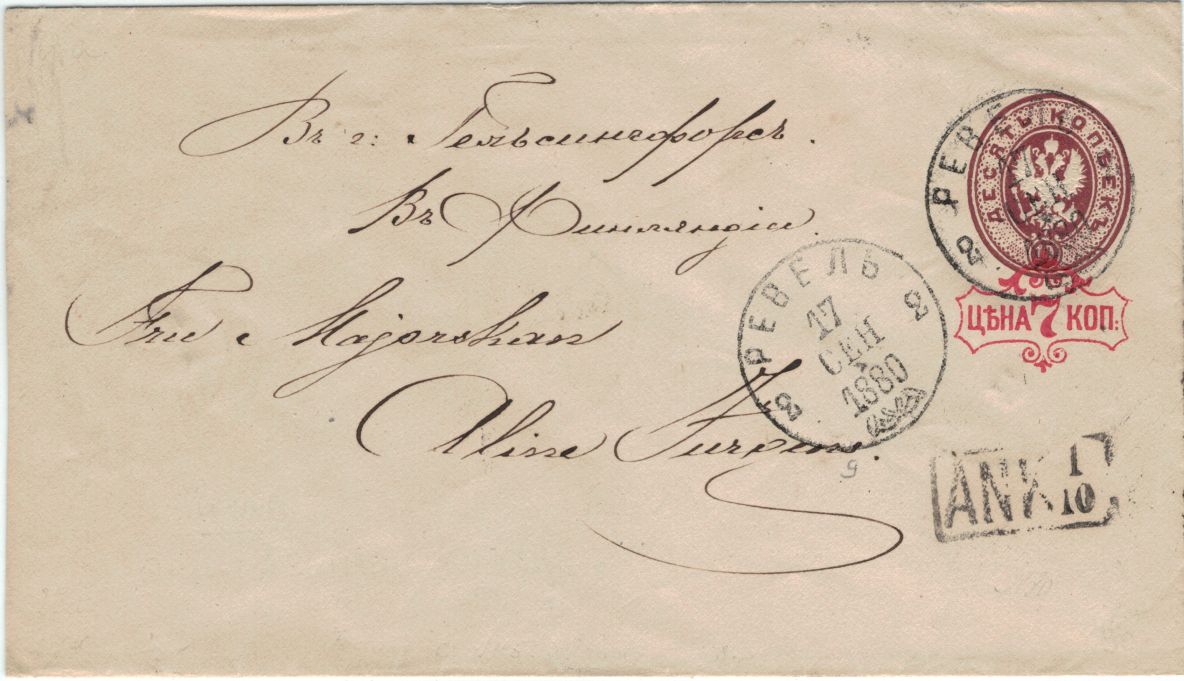
Another example of the time difference of 12 days between Julian and Grogorian calendars in the 19th century: Russian postal stationery Michel U 28A from Reval Sept. 17, 1880 (29.9.) via St. Petersburg Sept. 18, 1880 (reverse side) to Helsingfors/Helsinki with arrival postmark ANK (Ankunft) 1.10.
Railwaymail
The railway post offices and their route stamps were a special chapter between 1870 and 1918, as they were not subordinate to the imperial post office in the Tsarist empire, but were organised independently of it as a railway postal administration. For Estonia, the railway post office in St. Petersburg was responsible.

This postal stationery postcard (Michel Russia P4) was mailed on May 12, 1879 from Dorpat (railway post office cancel Hurt/Ojaste 2:1) to Taps (railway post office cancel Hurt/Ojaste 16:3 for route no. 89) to Hamburg.
Incidentally, the card is addressed to Prof. Dr. Wladimir Köppen (1846–1940), the doyen of German climate research and then head of section at the German Naval Observatory.
Wide-gauge lines
Between 1870 and 1904, the wide-gauge lines, which were important throughout the empire, were built and put into operation, before the narrow-gauge lines, which were only of regional importance, were started between 1896 and 1903. A characteristic feature of both was that they were initially planned, built and operated largely with private capital, before at least the wide-gauge lines were nationalised later on.
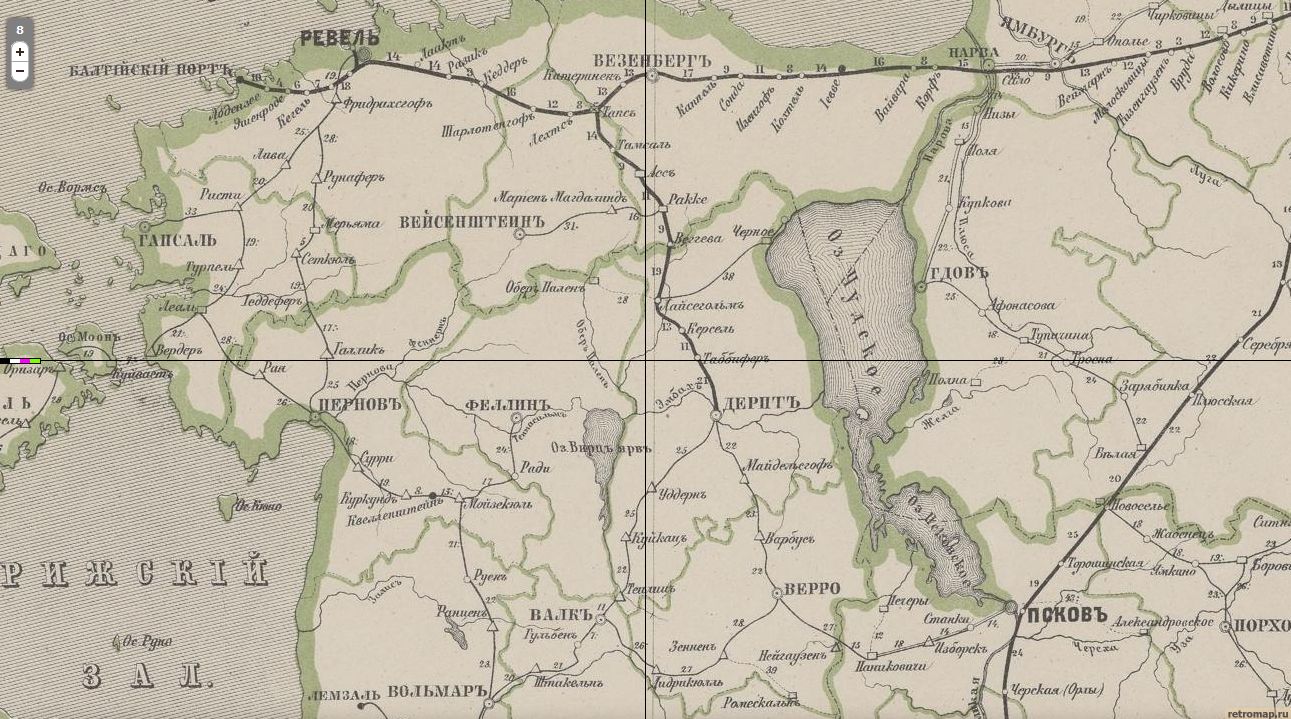
Historical Map of Postal Routes in Estonia 1881
(Image: Map from 1881 / Retromap – Sergei Tarasov)
The following wide-gauge (1524 mm gauge) railway lines were opened for scheduled traffic in Estonia:
1870 Baltischport – Reval – Gatschina (Paldiski – Tallinn – Gatshina)
1876 Taps – Dorpat (Tapa – Tartu)
1899 Dorpat – Walk – Pleskau (Tartu – Valga – Pskov)
1904 Keila – Hapsal (Keila – Haapsalu)
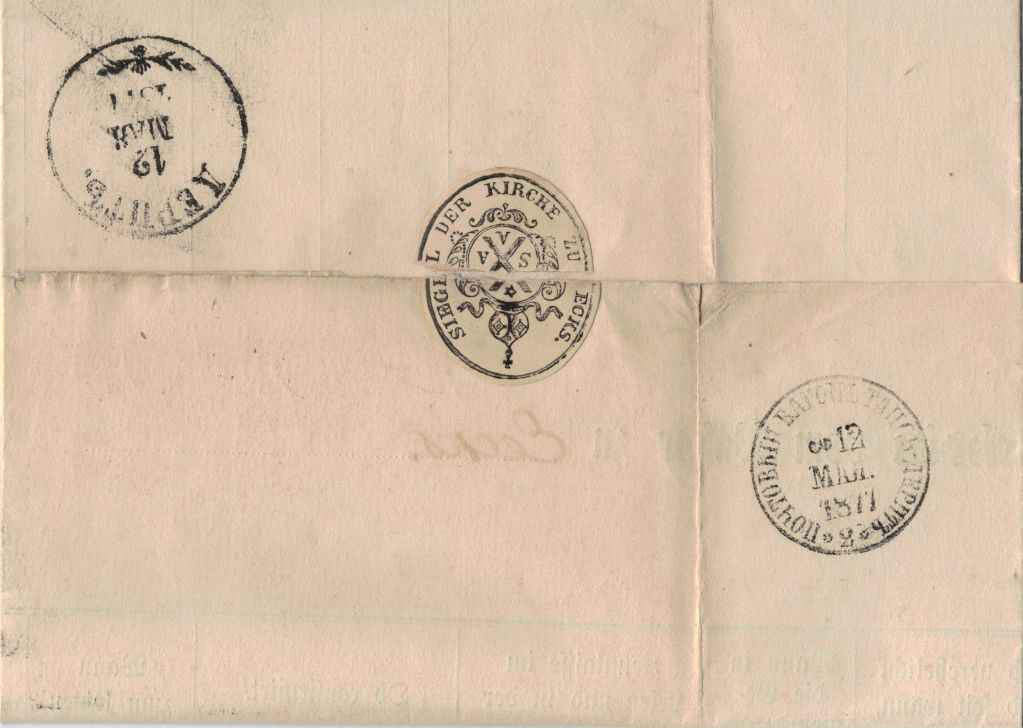
Postal item as evidence for the use of the wide gauge line Taps (Tapa) – Dorpat (Tartu): Postage paid parish letter from the pastor at Ecks (Äksi) only a few km north-northwest of Dorpat (Tartu) to the pastor at St. Peter's there. Cancellation postmark of May 12, 1877, Hurt/Ojaste 15:3.
Narrow-gauge lines
Opening of narrow gauge lines (750 mm gauge) for scheduled traffic in Estonia:
1896 Walk – Moiseküll – Pernau (Valga – Mõisaküla – Pärnu)
1897 Moiseküll – Fellin (Mõisaküla – Viljandi)
1901 Fellin – Tallinn (Viljandi – Tallinn)
1903 Walk – Mõniste – Stockmannshof (Valga – Mõniste – Stukmani/Plavinas)
1916 Walk – Alt-Schwanenburg (Valga – Vecgulbene)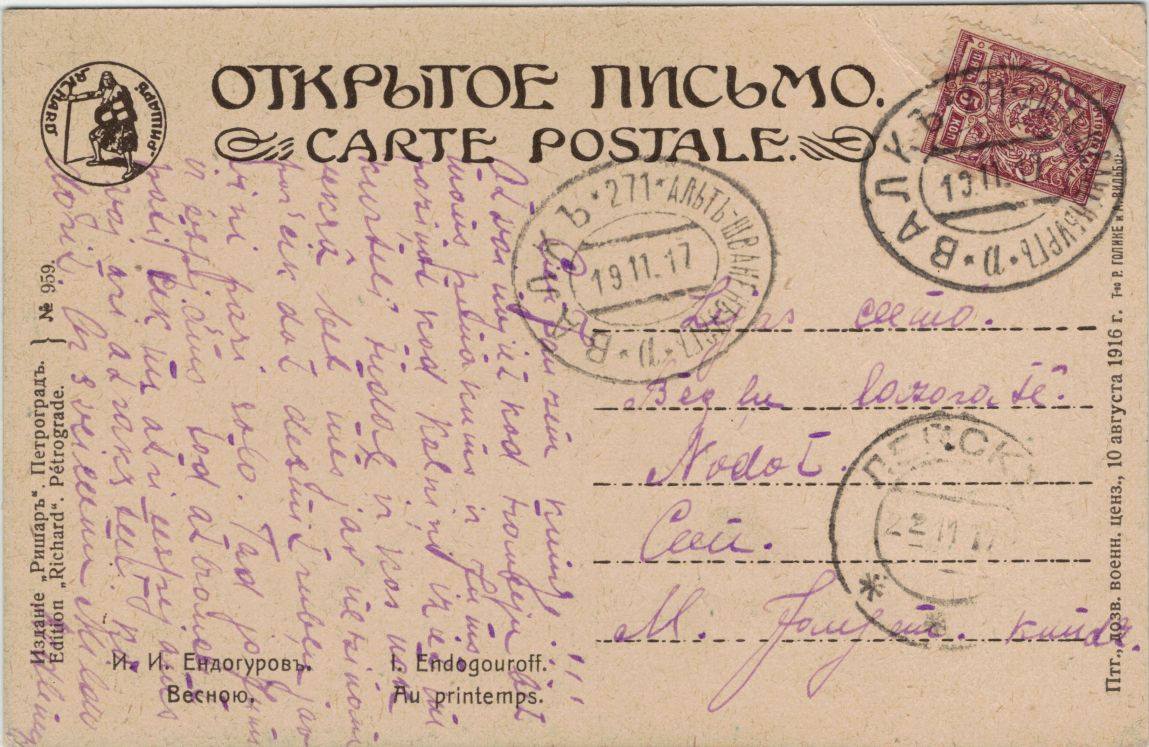
Postal item dated November 19, 1917 to Laisholm (Laiuse) / Lais station (Jõgeva), used on the narrow-gauge railway line from Alt Schwanenburg to Walk, with route cancel Hurt/Ojaste 39:1.
The line is south of Walk, so it had to be transferred to the wide-gauge line Walk – Dorpat and there in the direction of Taps to get to Lais station. For this, the card was on its way for 3 days.
Value letters
The value letter shown here for 43,000 rubles displays the highest known Russian letter franking in Estonia until 1917: 65.10 rubles.
This amount is made up of 61 rubles for the insured amount of cash in the letter plus 1.40 rubles for the sealing wax and 2.70 rubles for the registered letter.
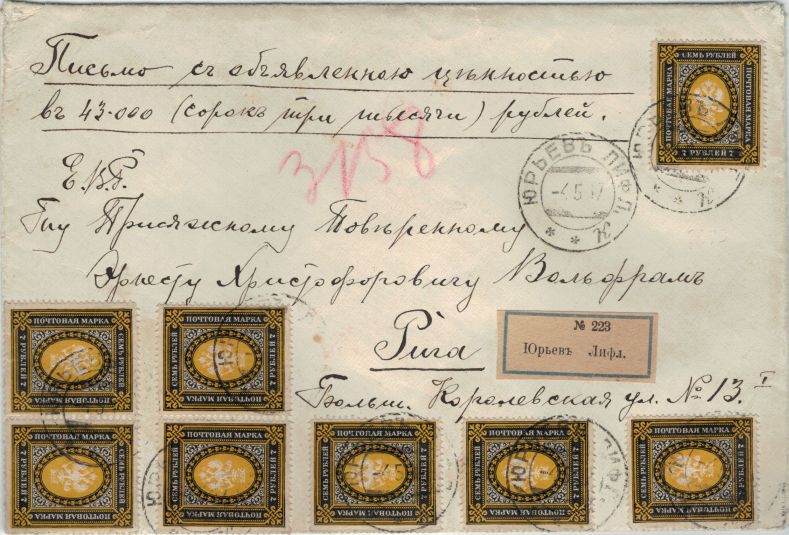
Letter of value (money) for 43,000 rubles from Jurjev (Dorpat/Tartu) in Livonia -4 5 17 to Riga -5 5 17.
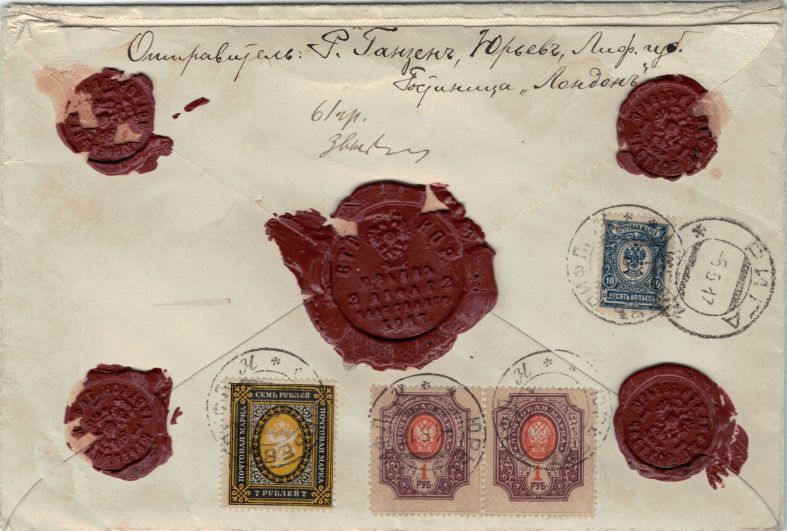
The postage was paid with 9 stamps at 7 rubles (Mi 56y), 2 stamps at 1 ruble (Mi 77Axb) and 1 stamp at 10 kopecks (Mi 69IAb).
World War 1
Silent postmarks – often not silent
The beginning of World War I brought great changes to the entire Baltic region. In the beginning, for security reasons, the Post tried to disguise the place of departure of a message by means of so-called " silent postmarks".
However, this quickly proved to be less successful when - as here - the sender in Allenküll (Türi) openly wrote his place of residence underneath and began his letter with "Terviseid Türilt" = "Greetings from Türi", which is why the measure did not have a long life.
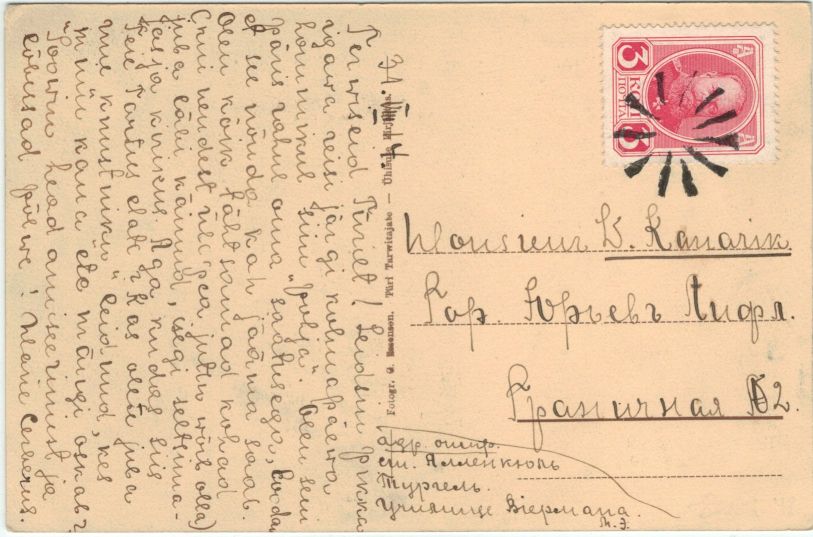
Silent postmark Türi (Allenküll), Hurt/Ojaste No. 3, on postcard dated August 31, 1914 (13.9.1914 according to Gregorian calendar) to Jurjev/Dorpat/Tartu
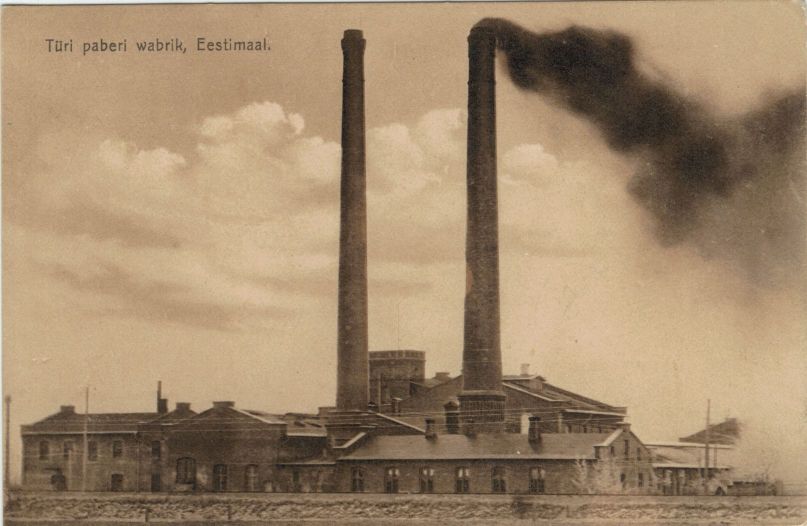
The picture side did not help either to disguise the sender: the "Türi paper factory, Estonia" sends its regards...
Occupation of Estonia
The area of present-day Estonia remained spared from direct warfare for a relatively long time during the First World War. It was not until October and November 1917 that German army and navy units occupied the Estonian Baltic islands, and at the end of February 1918 the Estonian mainland, largely without a fight.
-
German occupation / Ob. Ost
-
Independent Republic of Estonia
-
Soviet occupation
-
German occupation / Ostland
-
Camp Mail / Estonians in Exile
-
Independent Republic of Estonia (restored)
-
Private Mail in Estonia



